The Norfolk Terrier is a popular breed for people looking for a pet travel companion with a bunch of energy but a laid-back personality. This terrier is more than willing to socialize with bigger dogs and handles unfamiliar settings well. Cute and down-to-earth, it will go on walks, play fetch, learn tricks, and then enjoy lap time at the end of the day. The toy size, double coat of fur, and fun-loving personality make the breed a natural travel lover.
The Norfolk has a very close cousin in the Norwich Terrier. Both toy breeds make for great travel companions and were considered the same breed until 1979, but they can be distinguished from one another by their ears. The Norfolk’s downward-pointing “drop” ears gives it a small advantage for fitting comfortably inside its travel carrier.

…HAVE EVERYTHING?
Size and Travel Options
This is just about the perfect-sized dog for people who want a travel companion who can fly with them in the cabin of a plane. Between 9-10 inches tall and weighing about 11-12 pounds, the Norfolk Terrier will do best with a soft-sided carrier but with its low-sitting stocky frame, it should have little trouble overall. Not easily put off by hustle and bustle of public areas, this breed should be fine on planes, trains, subways, automobiles, and pretty much anywhere that is pet-friendly. Plus, the breed is hypoallergenic. The only catch is that it’s a good idea to keep your Norfolk Terrier on a leash in public areas. Its prey drive can be dangerous for birds and smaller animals.
Personality as a Travel Companion
This lively, energetic breed needs a good amount of exercise, whether it’s walks, playing games, or learning tricks. They’re not especially yappy or prone to separation anxiety, but they can act out when neglected for too long. Business travelers may want to pay for doggy daycare if they plan on long trips with a full business meeting schedule. A professional groomer is another expense you may want to plan for. The double coat of fur needs a special cut of hand-strip clipping to encourage new hair to grow in and keep the fur looking its best.
Again, don’t forget that this was originally a hunting breed. This can be great for frequent travelers who might otherwise be afraid of hotel bugs and rodents. It never hurts to have another form of home pest control, either. If visiting family for the holidays, be sure to separate and be mindful of pet birds, hamsters, and reptiles. But other friends and family can help keep your Norfolk Terrier entertained while you’re on an excursion that isn’t pet-friendly.
Health and Longevity
Generally healthy dogs, the Norfolk Terrier can be susceptible to certain, common health conditions including patellar luxation, and heart and eye issues. Regular visits to the vet are recommended, but often little follow-up care is needed throughout most of the breed’s adult life. A hearty dog overall, the breed’s life expectancy is 12-16 years.
Norfolk Terrier Breeders and Adoption Centers
You may be able to find an adoption or rescue dog, but many people who want a healthy puppy with strong pedigree end up turning to a reputable breeder. A slightly rarer breed than the Norwich, a Norfolk Terrier of strong pedigree from a reputable breeder may cost just a little more than a Norwich, which is something you may want to consider. The overall price range is quite similar with dogs found at adoption centers costing about $300, while puppies from a breeder might cost anywhere from $1,250-$4,000. The average cost tends to be a little higher around $2,000-$2,500 for a Norfolk Terrier.